Table of contents
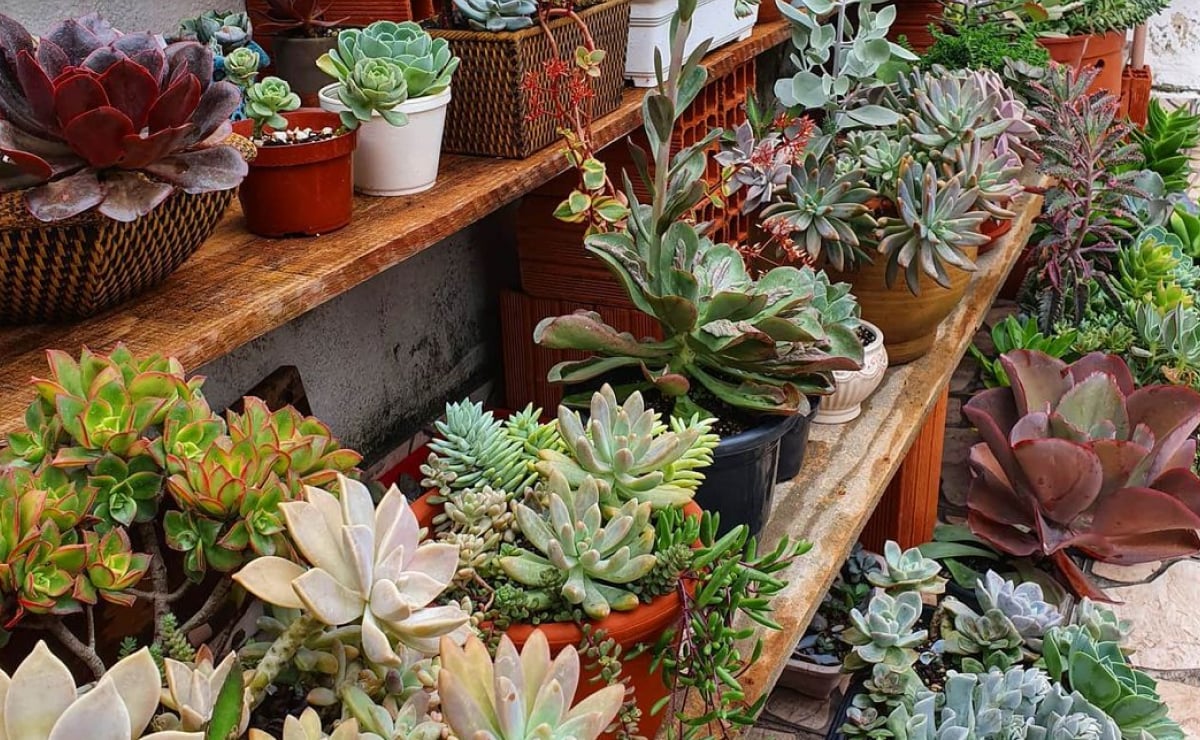
Succulents are plants that retain a lot of liquid in their leaves, so they don't need a lot of watering. This has made them the darling of apartments, being confused with cacti. These are indeed succulents, but not all are cacti. Below, check out the main types of succulents and choose which species you want to grow!
1. pearl necklace (Senecio rowleyanus)
- Key features: This type of succulent is known as a string of pearls thanks to its visual appearance. The leaves look like peas or a green string of pearls when the succulent is hanging. In spring, white, cinnamon-scented flowers can still appear.
- Size: from 50 centimeters to 1 meter.
- Sun exposure: it is important that it receives light, but not direct sunlight on it.
- Watering: The substrate must be dry between one watering and the next.
- Soil Type: well drained and porous.
- Fertilization: twice a year with worm humus, coffee powder, or eggshell meal.
Usually, the pearl necklace is placed in tall pots so that the leaves hang down. However, this succulent can also be placed in a low pot and be grown creeping. See examples:

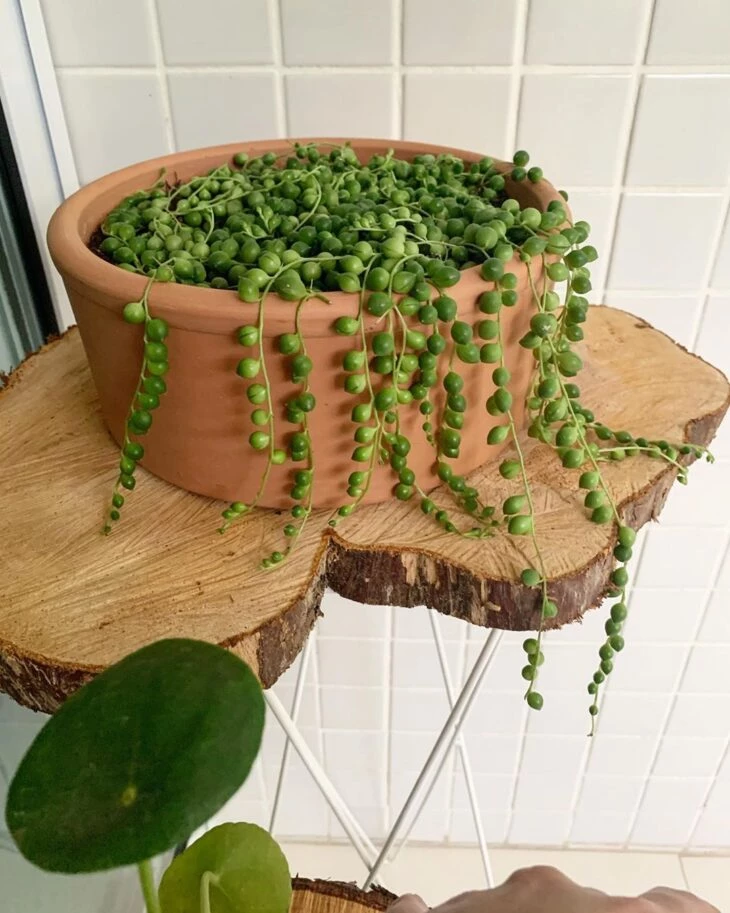

The pearl necklace is also known as a rosary or green pearl. Regardless of the name, this succulent gives a special charm both indoors and outdoors.
2. fat star (Sedum multiceps)
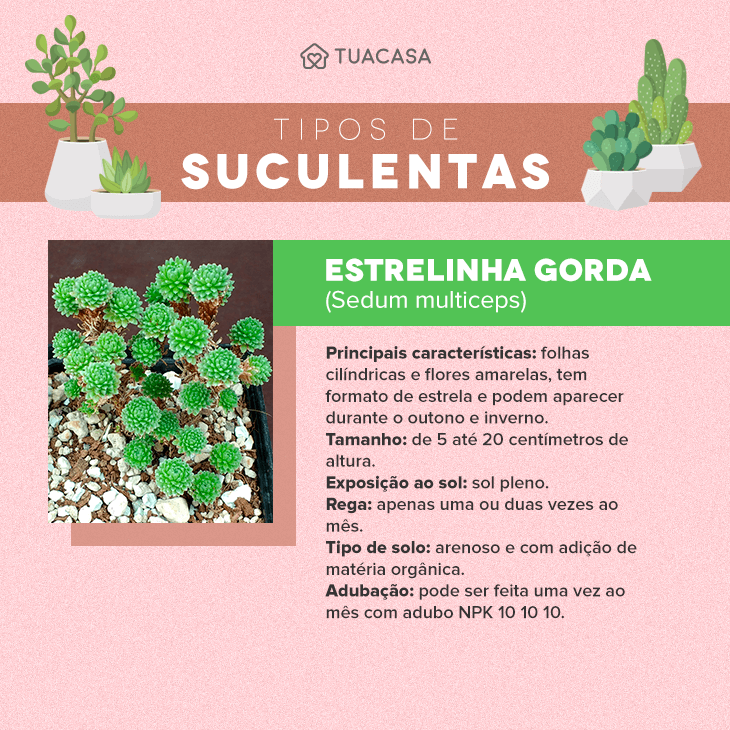
- Key features: is known as the fat star due to its cylindrical leaves and the species' flowers. The flowers are yellow, star-shaped, and can appear during fall and winter.
- Size: from 5 to 20 centimeters high.
- Sun exposure: full sun.
- Watering: only once or twice a month.
- Soil Type: sandy and with added organic matter.
- Fertilization: can be done once a month with NPK 10 10 10 fertilizer.
The little fat star is easy to grow, but is still not often seen in Brazilian homes. How about putting one in your home? Take a look at how it can be grown:
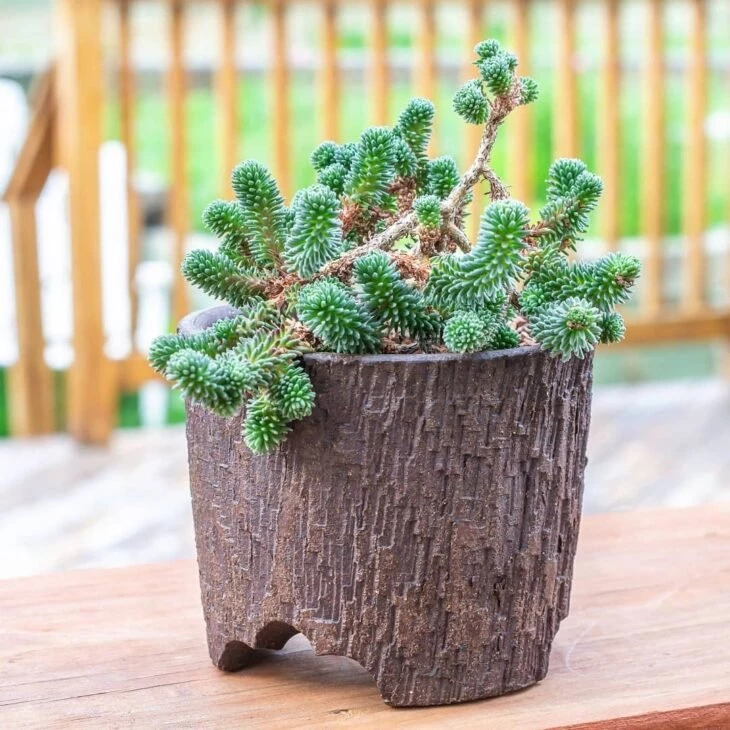
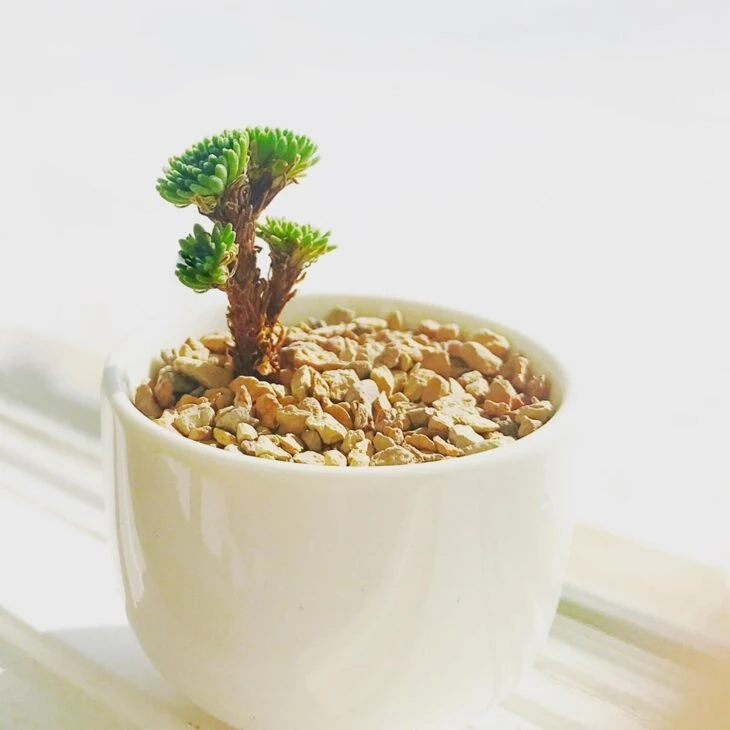
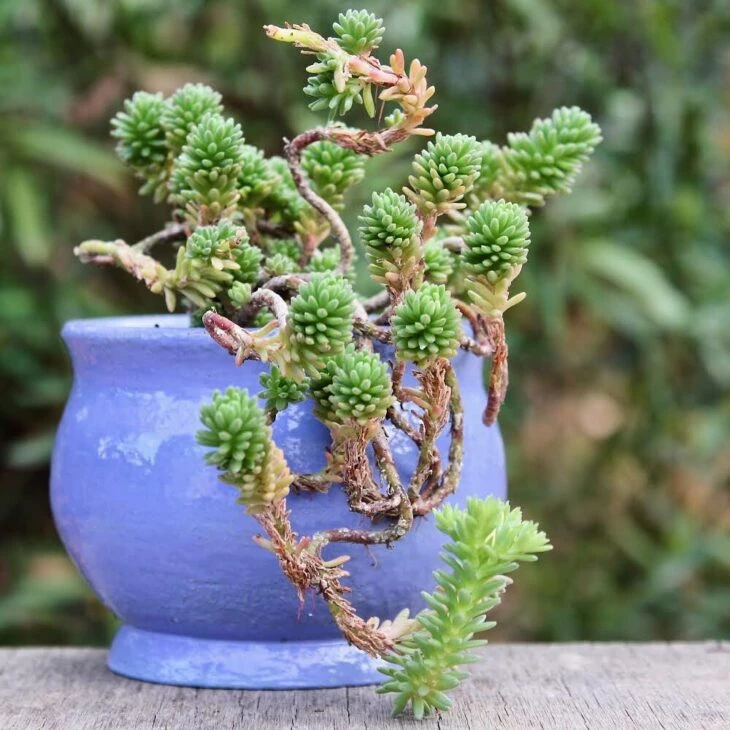
The little fat star is very small and can be placed in various rooms of the house, as long as it is exposed to the sun. When its branches hang from the vases, there is no one who is not enchanted!
3. elephant ear (Kalanchoe tetraphylla)
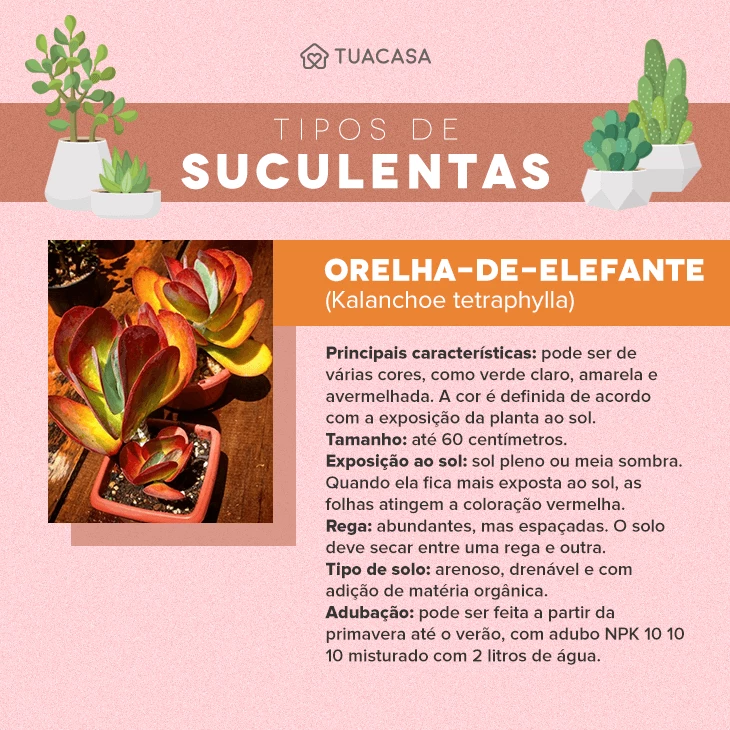
- Key features: This succulent, as the name implies, looks visually like an elephant's ears. It can be of various colors, such as light green, yellow, and reddish. The color is defined according to the plant's exposure to the sun.
- Size: up to 60 centimeters.
- Sun exposure: When it gets more sun, the leaves turn red.
- Watering: The soil must dry out between one watering and the next.
- Soil Type: sandy, drainable, and with added organic matter.
- Fertilization: can be done from spring through summer, with NPK 10 10 10 fertilizer mixed with 2 liters of water.
The elephant ear plant looks good in pots indoors as well as in gardens. Inside the house, you can put it in small pots that highlight the succulent's leaves. In the second option, you can put pebbles in the soil to make the plant even more charming. Check out some examples:

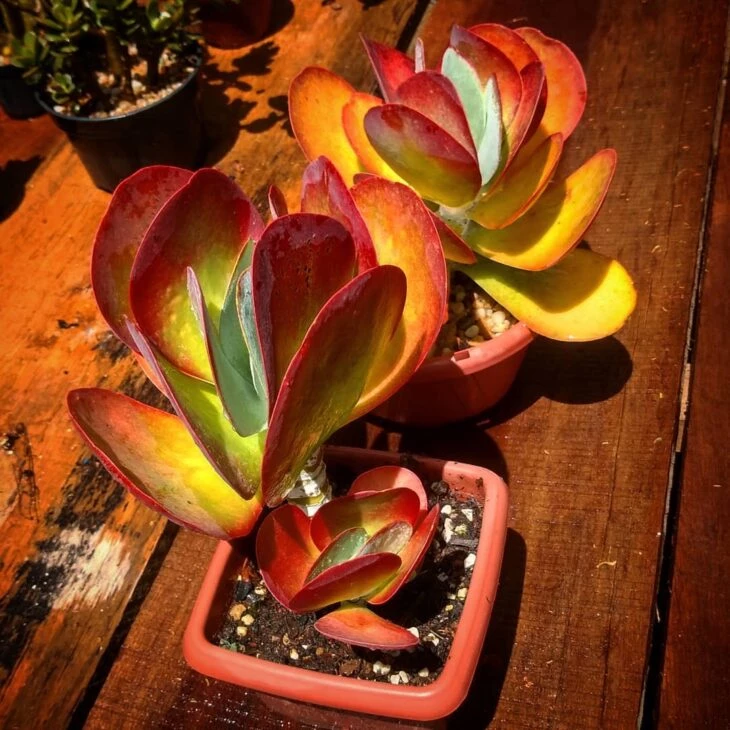

If you want, you can even combine this species with other succulents that have smaller leaves to also enhance the look of the elephant ear.
4. shrek's ear (Crassula ovata Gollum)
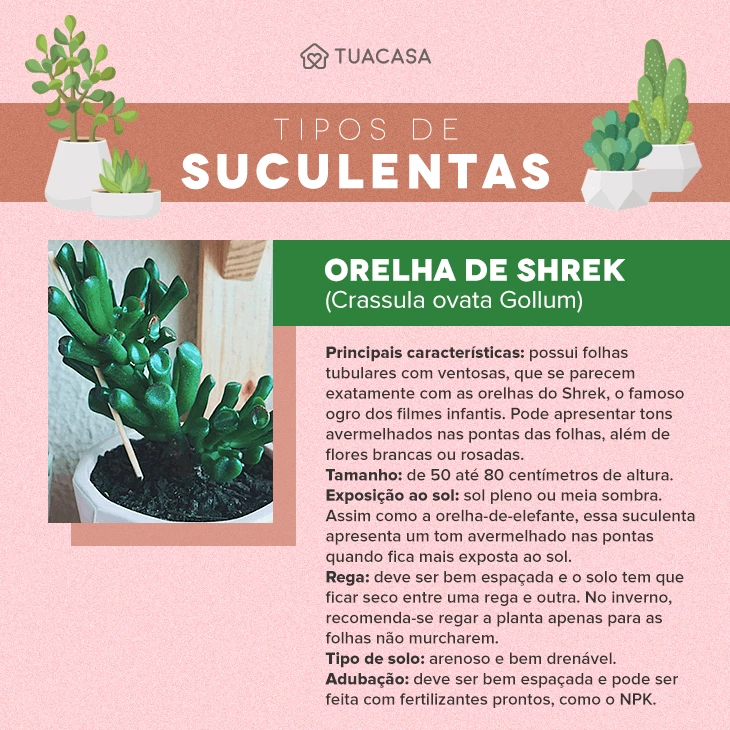
- Key features: The shape of this succulent is unique. It has tubular leaves with suckers that look exactly like the ears of Shrek, the famous ogre from the children's movies. It can have reddish tones on the tips of the leaves, and white or pinkish flowers.
- Size: from 50 to 80 centimeters in height.
- Sun exposure: Like the elephant ear, this succulent has a reddish tinge at the tips when it is exposed to the sun.
- Watering: In winter, it is recommended to water the plant only so that the leaves do not wither.
- Soil Type: sandy and well-drained.
- Fertilization: should be well spaced and can be done with ready-made fertilizers, such as NPK.
The growth of this plant is slow, so you can make good use of the different stages of the succulent. See Shrek's ear in different sizes:
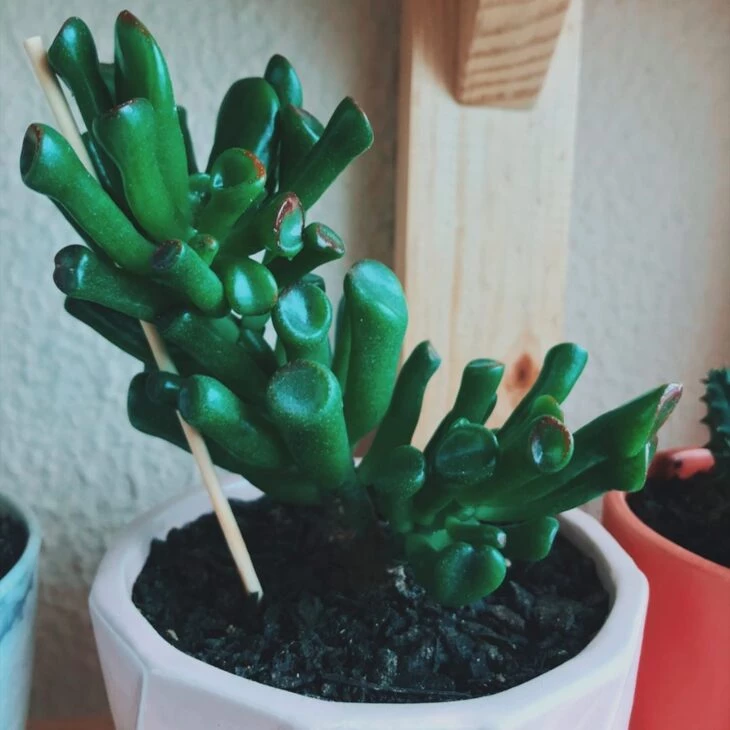

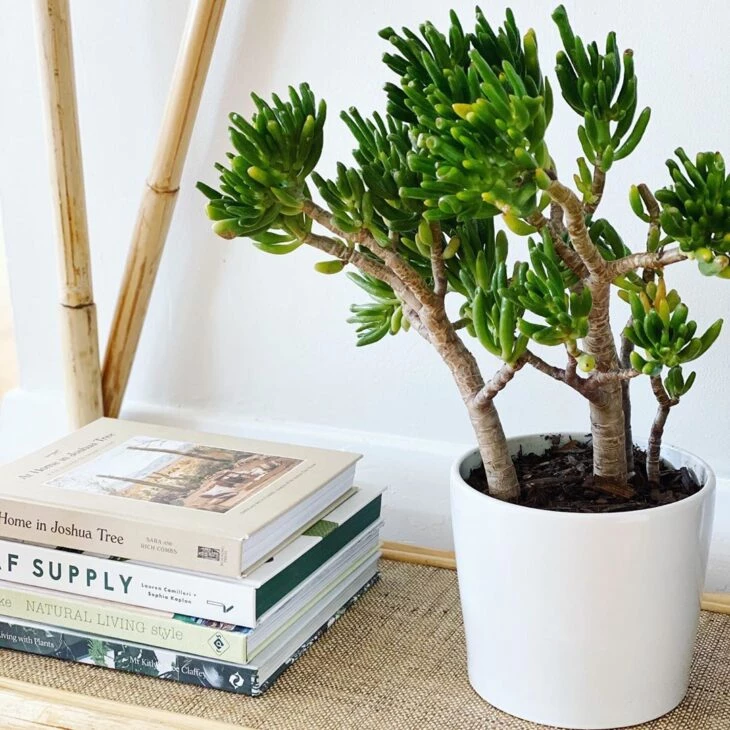
Since Shrek's ear does well in full sun as well as in part shade, and the care of the plant is minimal, it is widely used inside houses and apartments. How about adding one to your decor?
5. ghost plant (Graptopetalum paraguayense)
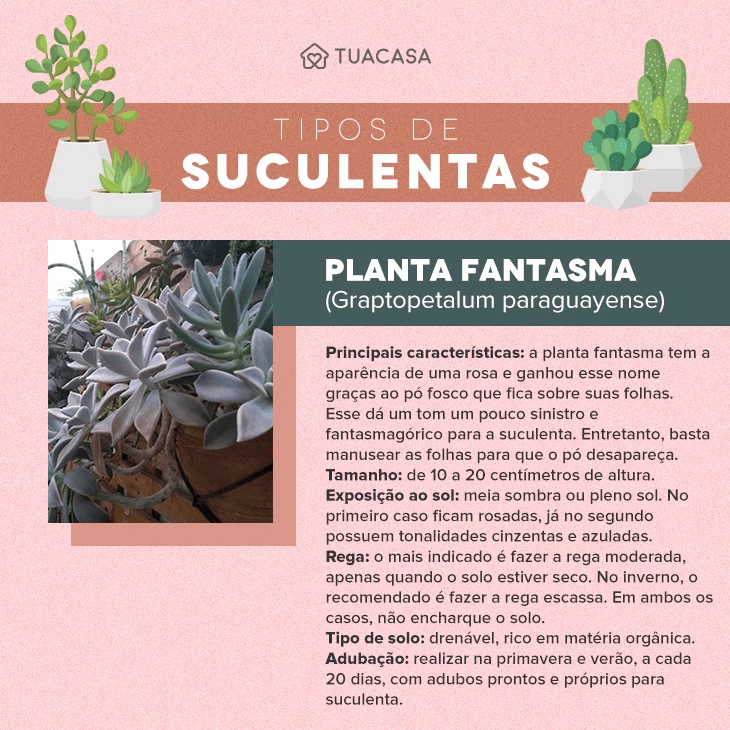
- Key features: The ghost plant has the appearance of a rose and got its name thanks to the matted powder that sits on its leaves. This gives a somewhat sinister and ghostly tone to the succulent. However, by simply handling the leaves, the powder disappears.
- Size: 10 to 20 centimeters high.
- Sun exposure: In the first case they turn pink, while in the second they have grayish and bluish tones.
- Watering: The best thing to do is to water moderately, only when the soil is dry. In winter, it is recommended to water sparingly. In both cases, do not soak the soil.
- Soil Type: drainable, rich in organic matter.
- Fertilization: in the spring and summer, every 20 days, with ready-made fertilizers suitable for succulents.
The ghost plant looks very charming in tall pots, as it is a pendant species. Besides, it gets along well with other plants. Check it out:

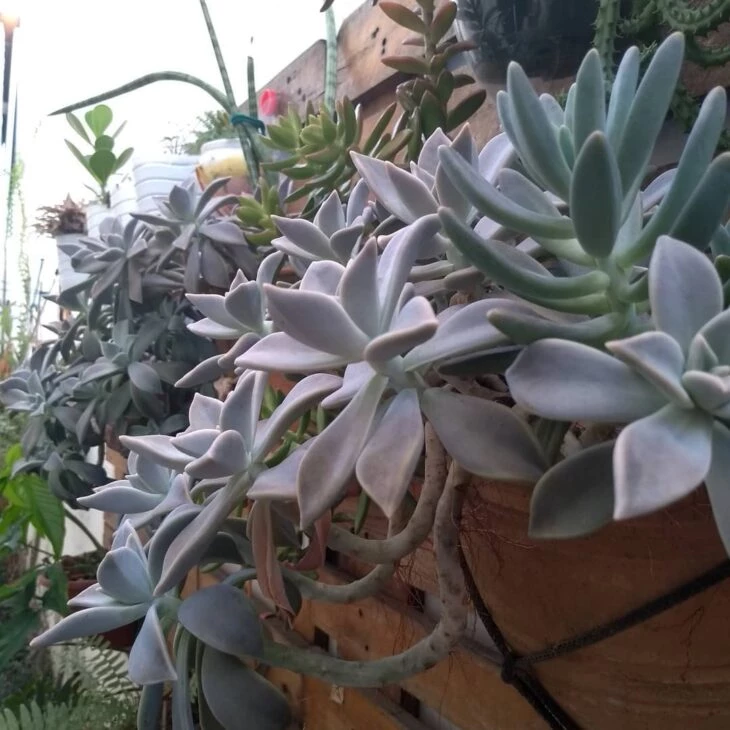
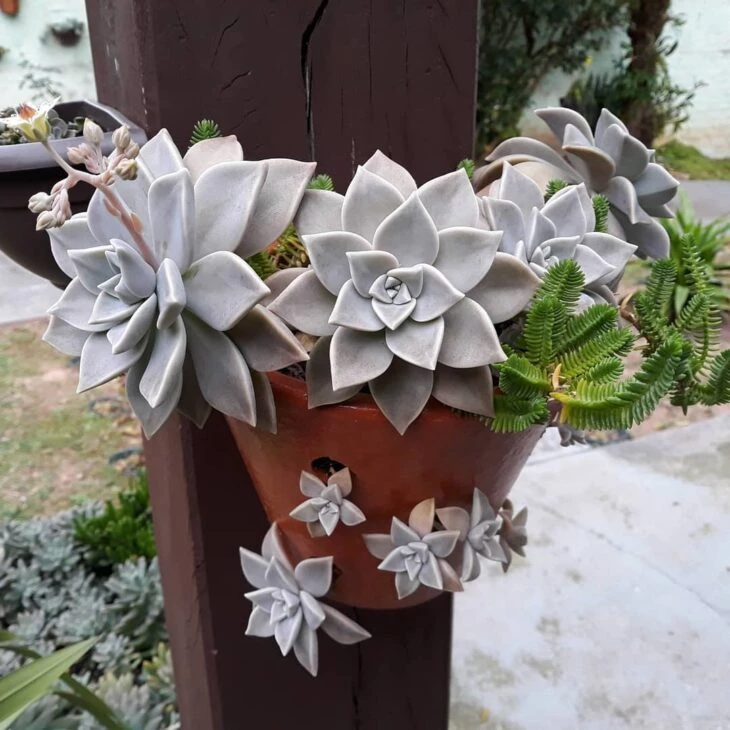
This type of succulent is often found in houses and apartments because of the charm of its rose-like appearance and the changing colors of its leaves.
6. jade plant (Crassula ovata)

- Key features: This succulent has a similar appearance to Shrek's ear, however its leaves do not form a "sucker". They are thicker and jade green, hence the popular name of the species. In autumn, white or pink flowers may appear.
- Size: from 40 centimeters to 1.8 meters.
- Sun exposure: full sun or half shade.
- Watering: In winter, it is recommended to decrease the frequency even more and water only to prevent the leaves from wilting.
- Soil Type: well drained, sandy and with added organic matter.
- Fertilization: it is recommended to do it in spring and summer, with specific fertilizers for succulents.
The jade plant is well known for being a symbol of Feng Shui. According to this art, the succulent is capable of balancing the energies of both an environment and the individuals who live there. For this reason, many people choose this species to put in their homes. See:
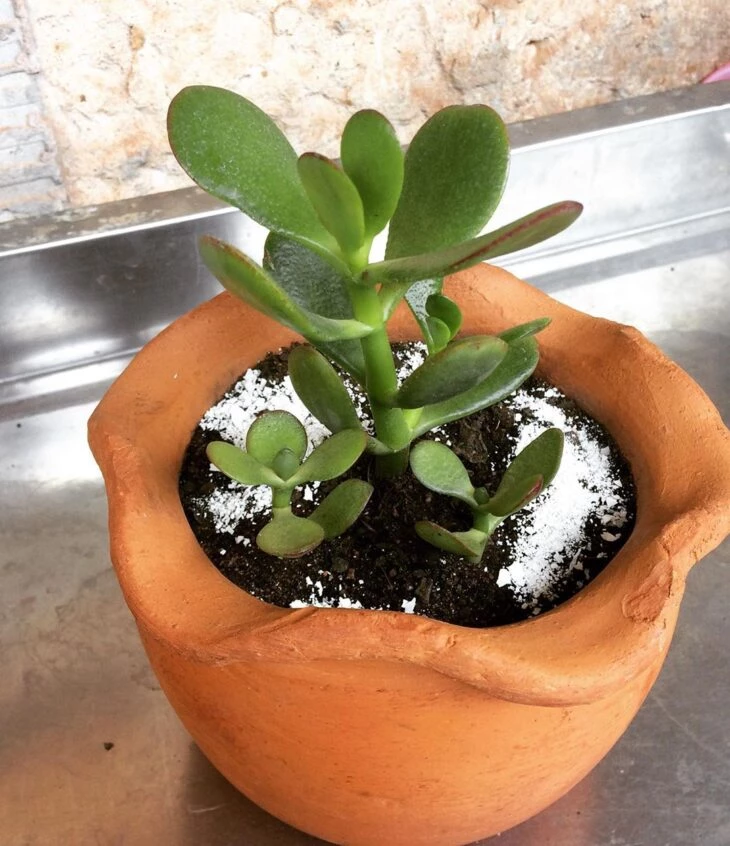
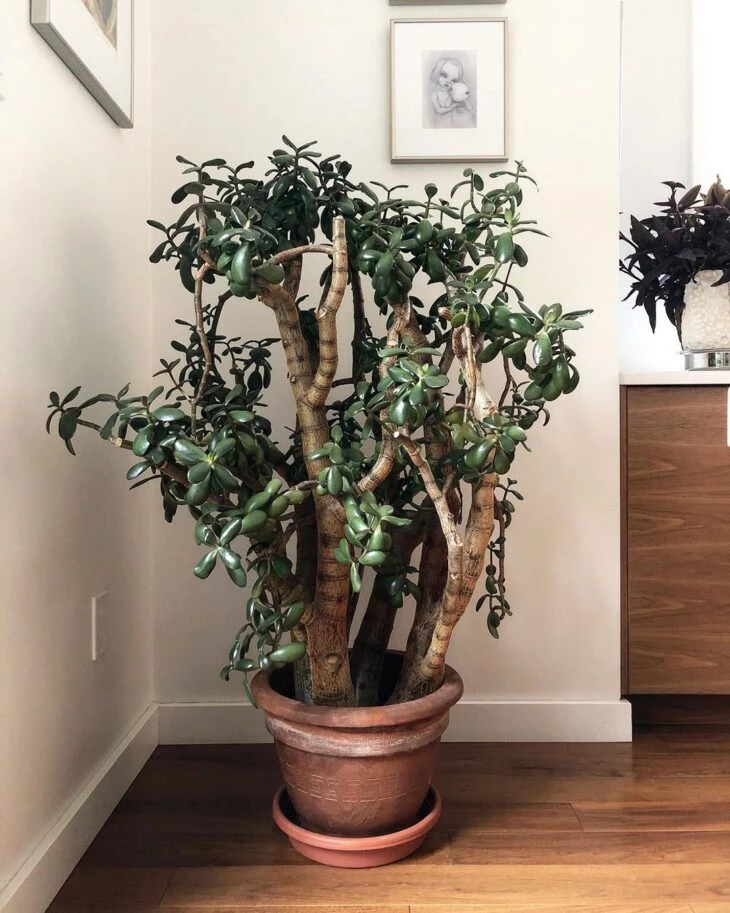

Regardless of why it is chosen to decorate houses and apartments, it is a fact that it makes environments more beautiful!
7. foxglove (Sedum morganianum)
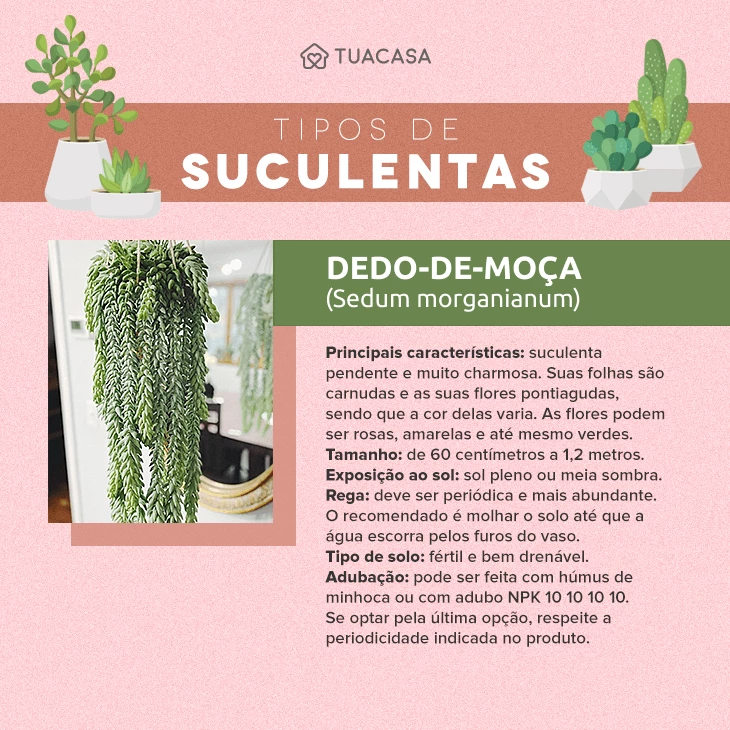
- Key features: The Finger-of-the-Moon is a very charming pendulous succulent. Its leaves are fleshy and its flowers pointed, and their color varies. The flowers can be pink, yellow, and even green.
- Size: from 60 centimeters to 1.2 meters.
- Sun exposure: full sun or half shade.
- Watering: It is recommended to wet the soil until the water runs through the holes in the pot.
- Soil Type: fertile and well-drained.
- Fertilization: can be made with worm humus or with NPK 10 10 10 fertilizer. If you choose the latter option, respect the periodicity indicated on the product.
The species is commonly confused with the pigtail (Sedum burrito) As the finger-of-moça is a pendant, it looks especially charming in high or hanging pots, however, it also goes well in low pots. Check out some examples:
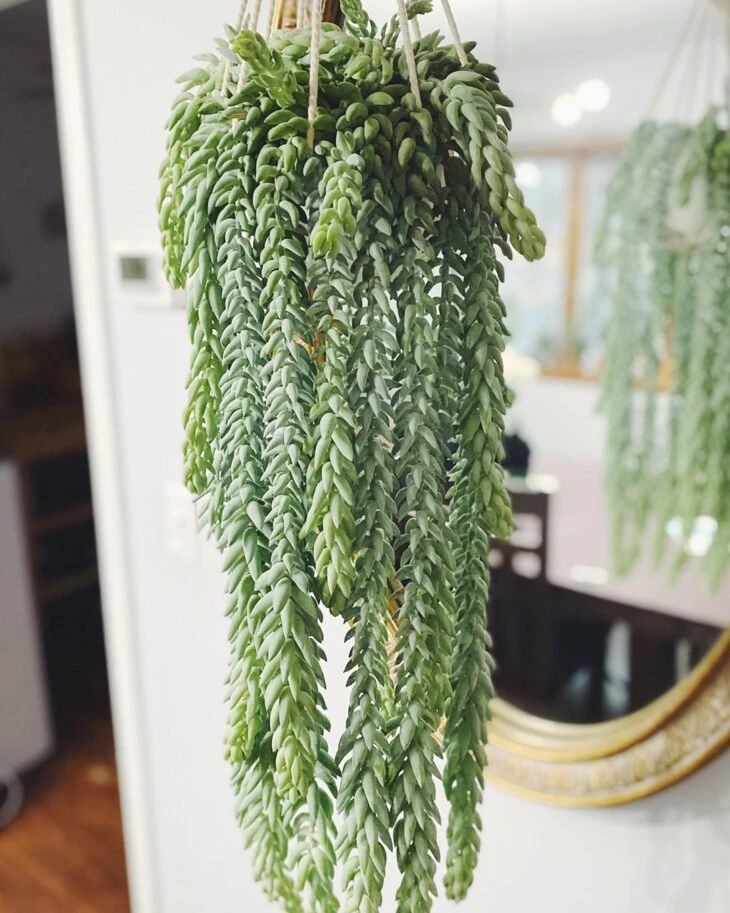
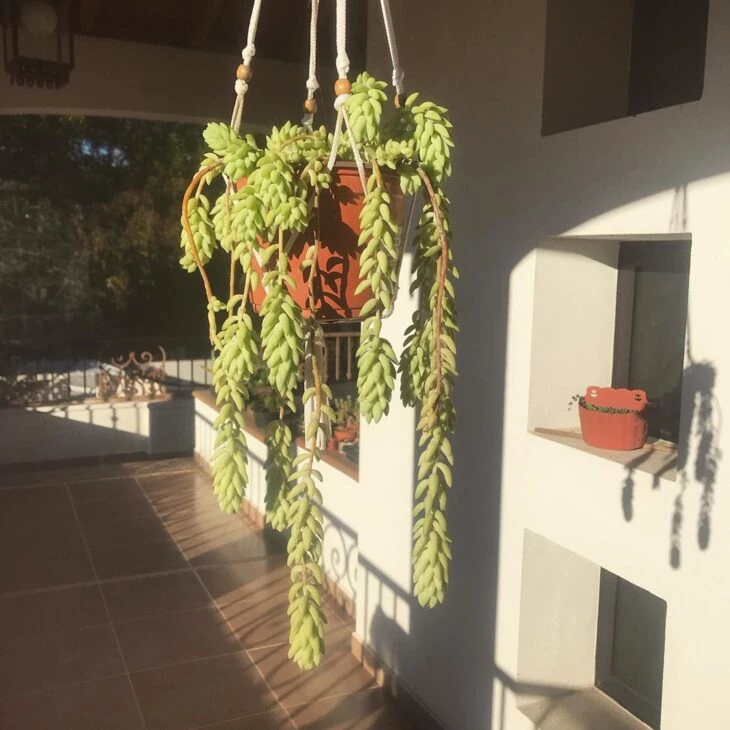

If you choose this type of succulent for your home, remember to put it in a pot that has drainage holes or micro-holes, such as clay pots.
8. stone rose (Echeveria elegans)

- Key features: Also known as the Mexican snowball, the rock rose is one of the most popular succulents in Brazil. Its appearance is that of a blooming rose and its colors vary, being green or more grayish.
- Size: from 5 to 20 centimeters.
- Sun exposure: Half-shade. It is important that the stone rose receives sunlight, but not directly all day.
- Watering: should be done once a week in summer and once a month in winter.
- Soil Type: rich in organic matter and well-drained.
- Fertilization: can be done every 4 months, with specific fertilizers for succulents.
Because it is small, the stone rose can decorate indoors, as long as it is near lighted windows. Outside the house, you must remember not to leave it in the sun all day. See ideas:



After these photos there is no need to explain why the rock rose is one of the most popular succulent species, is there?
9. sun rose (Aptenia cordifolia)
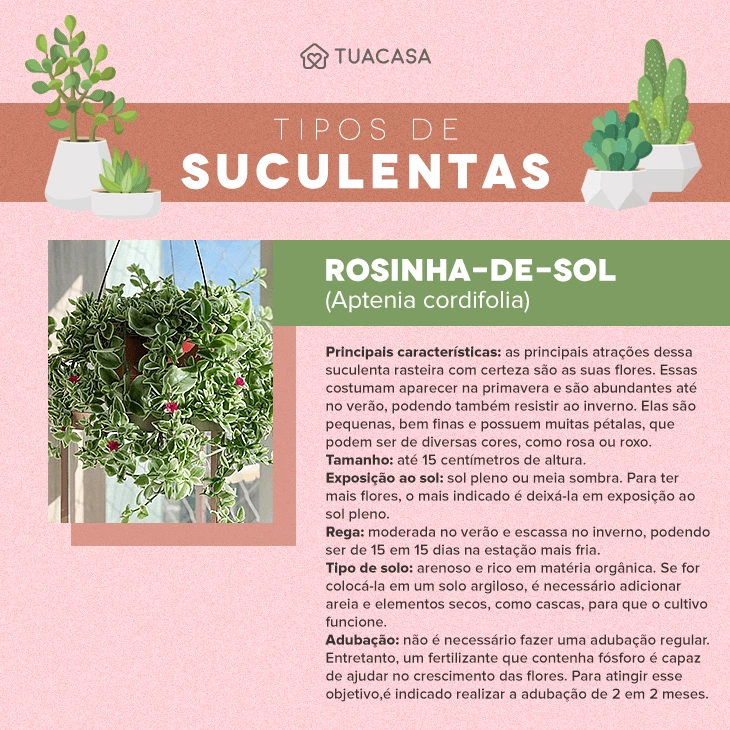
- Key features: The main attractions of this creeping succulent are of course its flowers, which usually appear in spring and are abundant even in summer, and can also withstand winter. They are small, very thin, and have many petals, which can be of various colors, such as pink or purple.
- Size: up to 15 centimeters high.
- Sun exposure: To have more flowers, it is best to leave it in full sun.
- Watering: moderate in the summer and scarce in the winter, and may be every 15 days in the colder season.
- Soil Type: If you put it in a clay soil, you need to add sand and dry elements, such as bark, for the cultivation to work.
- Fertilization: However, a fertilizer containing phosphorus can help the flowers to grow. To achieve this goal, it is recommended to fertilize every 2 months.
Although they are low hanging, rosehips can be found in many places to enhance a room's decor. Whether on a coffee table or even hanging, they can really make a space more pleasant! Check them out:


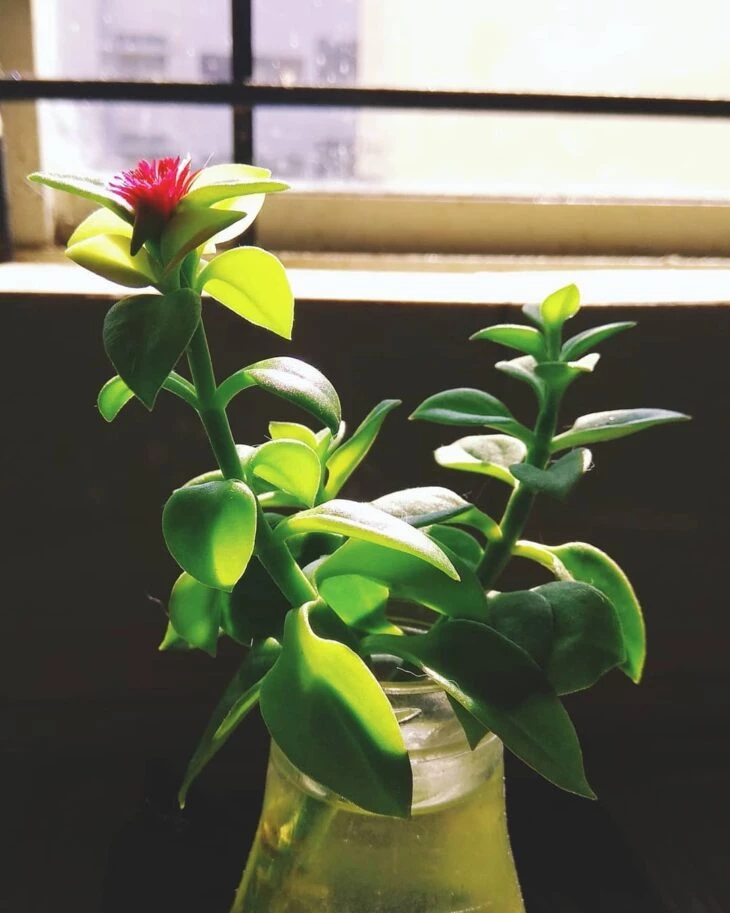
If you want to have a rose bush in your home, here's a curiosity: the flowers of this succulent open only when there is sunlight. After that, they close. So don't forget to put it in a place where it will be illuminated by the sun.
10. zebra (Haworthia fasciata)
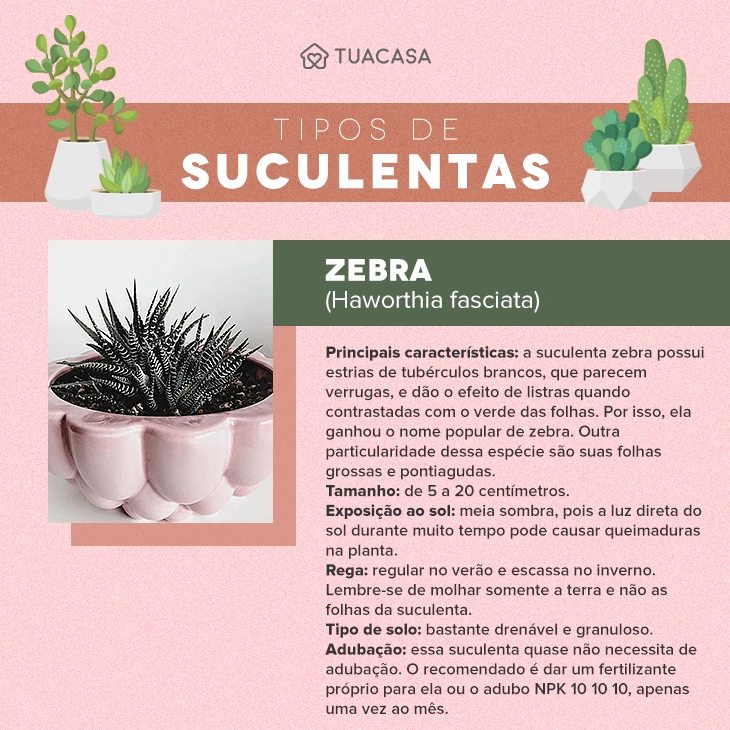
- Key features: The zebra succulent has striations of white tubercles, which look like warts, and give the effect of stripes when contrasted with the green of the leaves. This is why it earned the popular name zebra. Another particularity of this species is its thick, pointed leaves.
- Size: from 5 to 20 centimeters.
- Sun exposure: Half-shade, because direct sunlight for too long can cause the plant to burn.
- Watering: Remember to only water the soil and not the leaves of the succulent.
- Soil Type: quite drainable and granular.
- Fertilization: This succulent needs almost no fertilizing, but it is recommended to give it a fertilizer of its own, or the NPK 10 10 10 fertilizer, only once a month.
The more rustic appearance of this succulent species does not please everyone. However, it is also a good option to decorate and green your home. See examples:


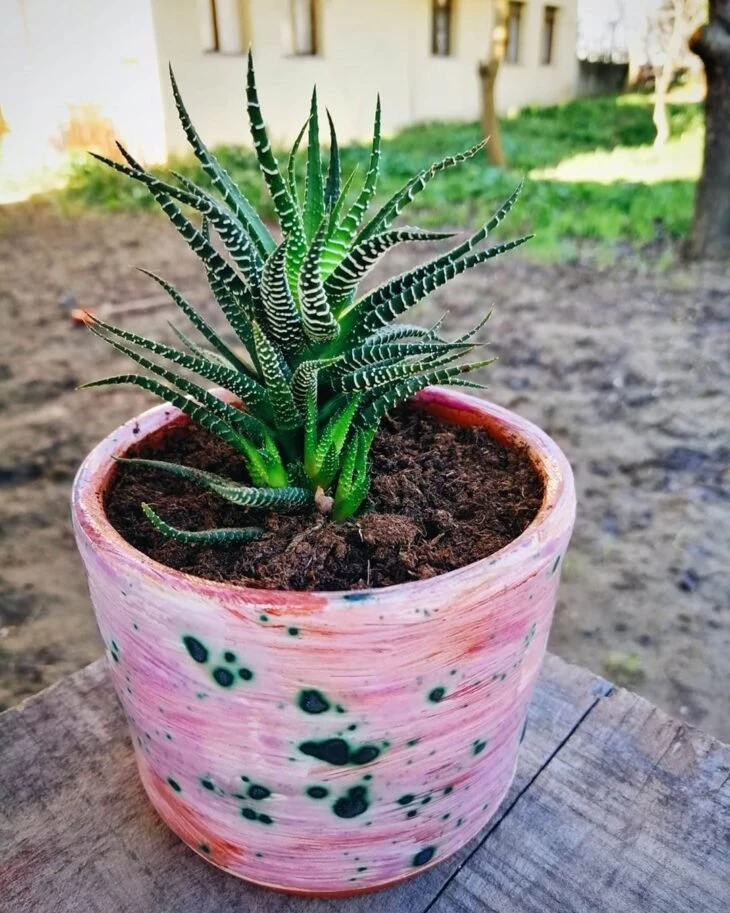
Zebras still go very well with other plants and are great to have in gardens or arrangements with other succulents.
See_also: 95 color options that go with brown for every roomThe 10 types of succulents we show here are options that you can look at to decide which one you want to have in your home or even office. If you can't choose just one species, how about making a succulent hanging garden?
See_also: Wallpaper in the bathroom: 55 beautiful options for a practical renovation

